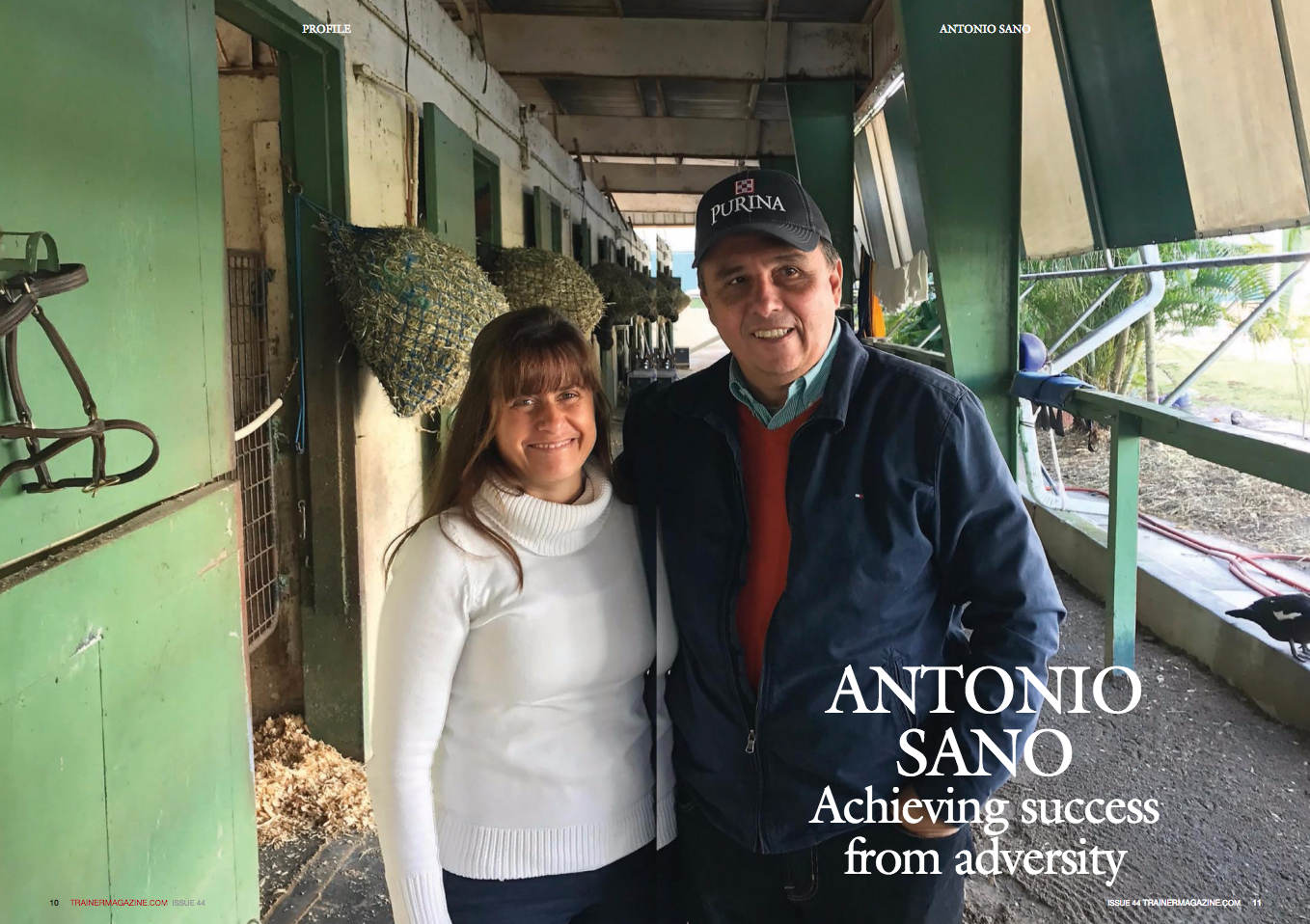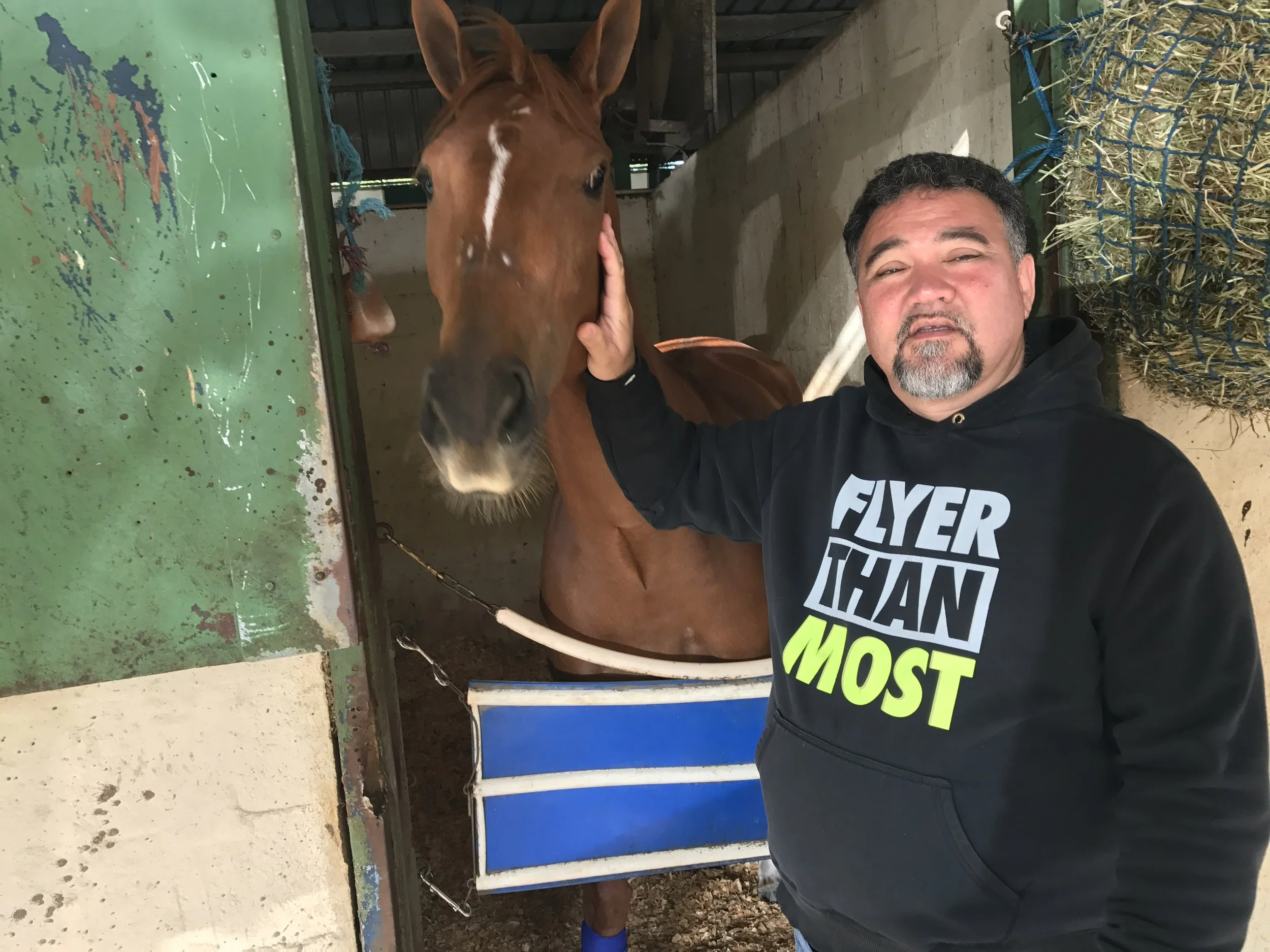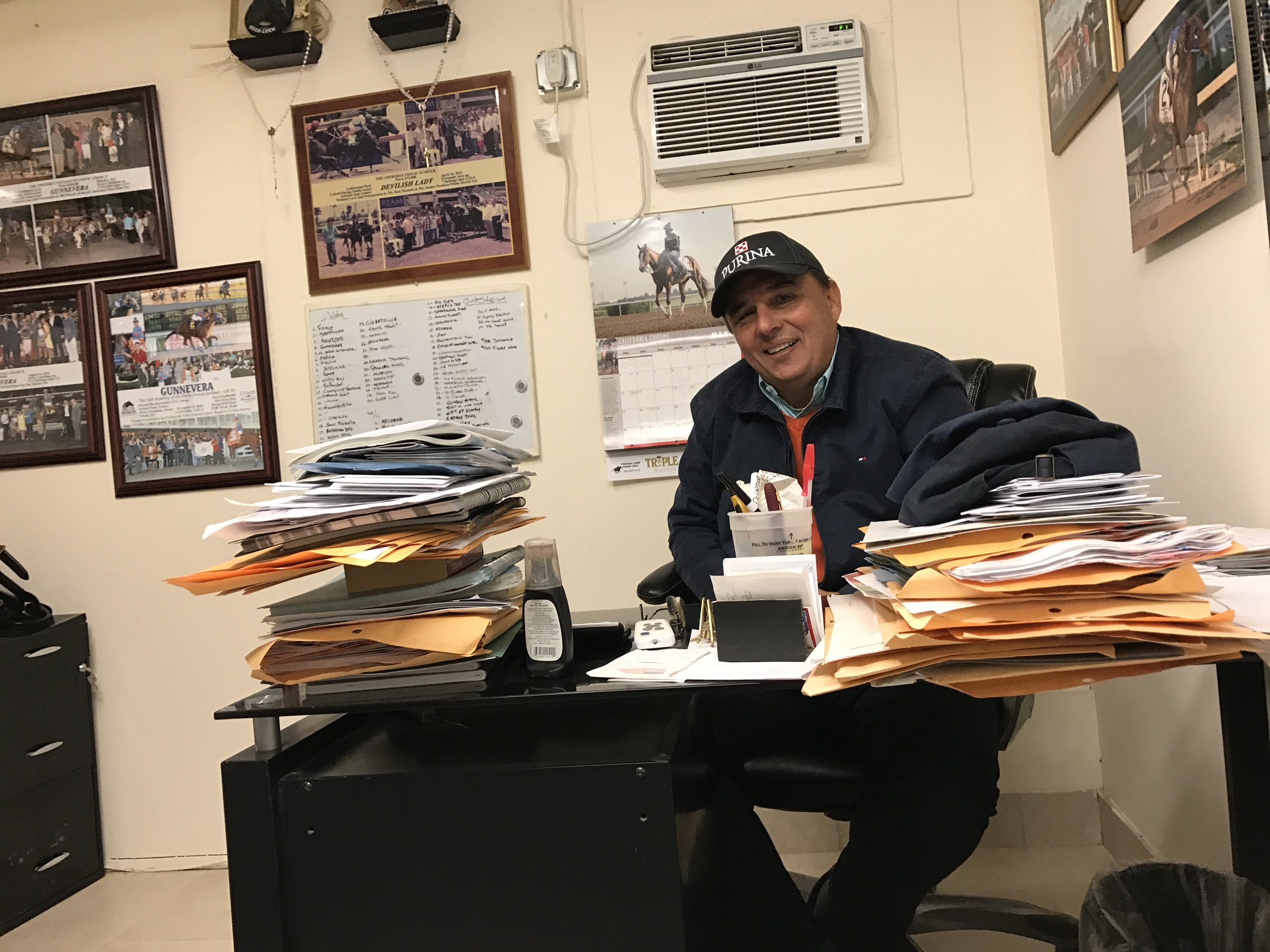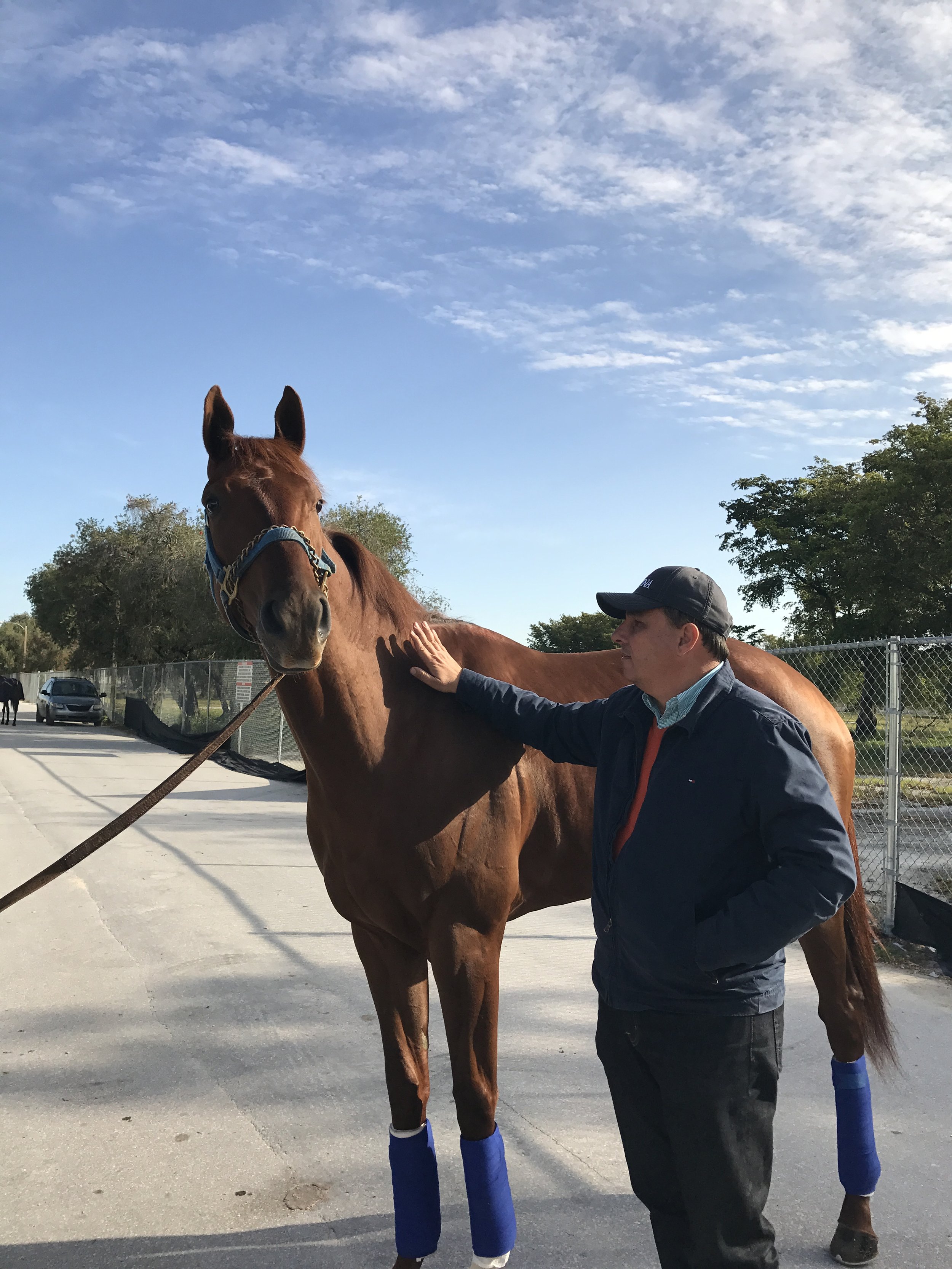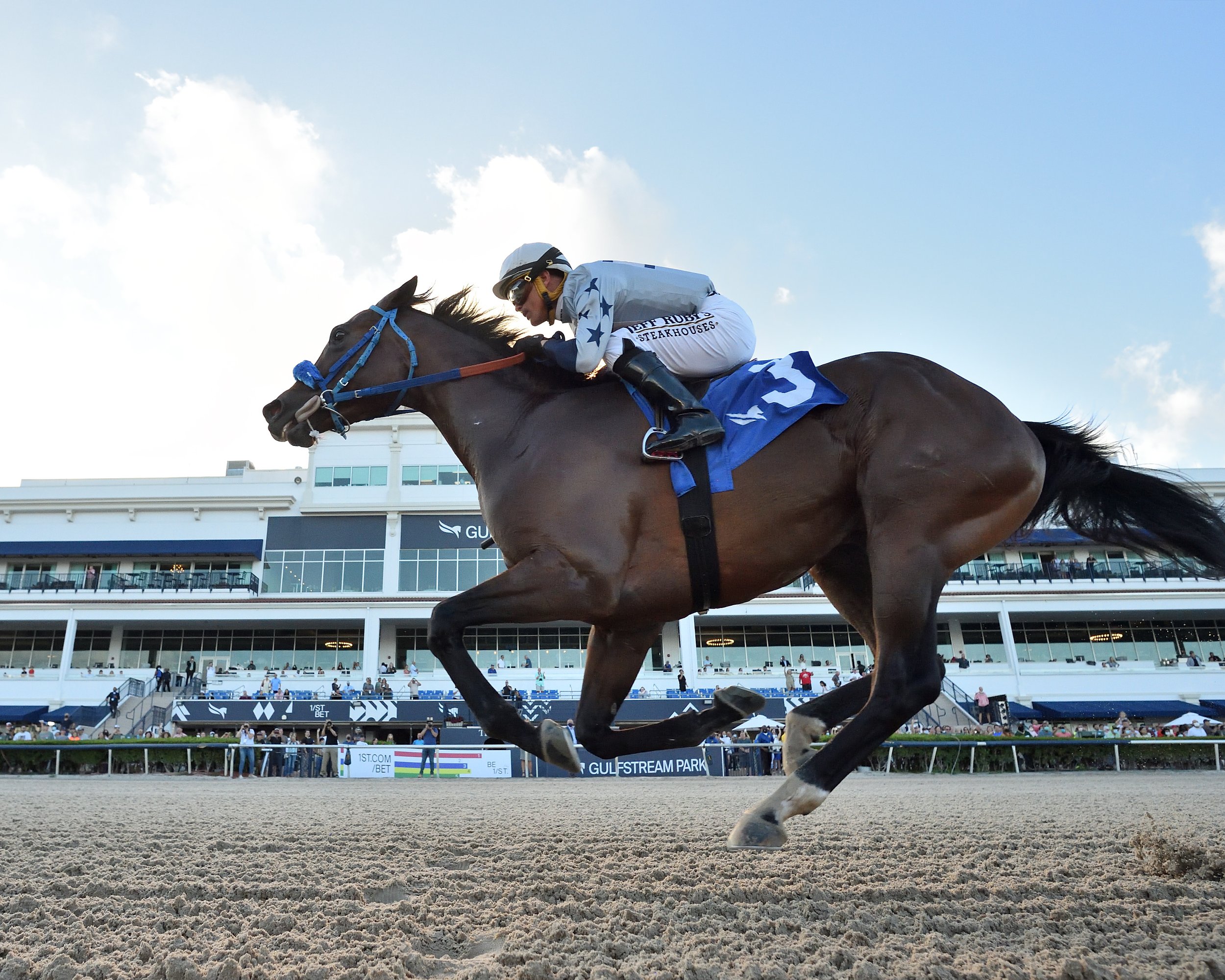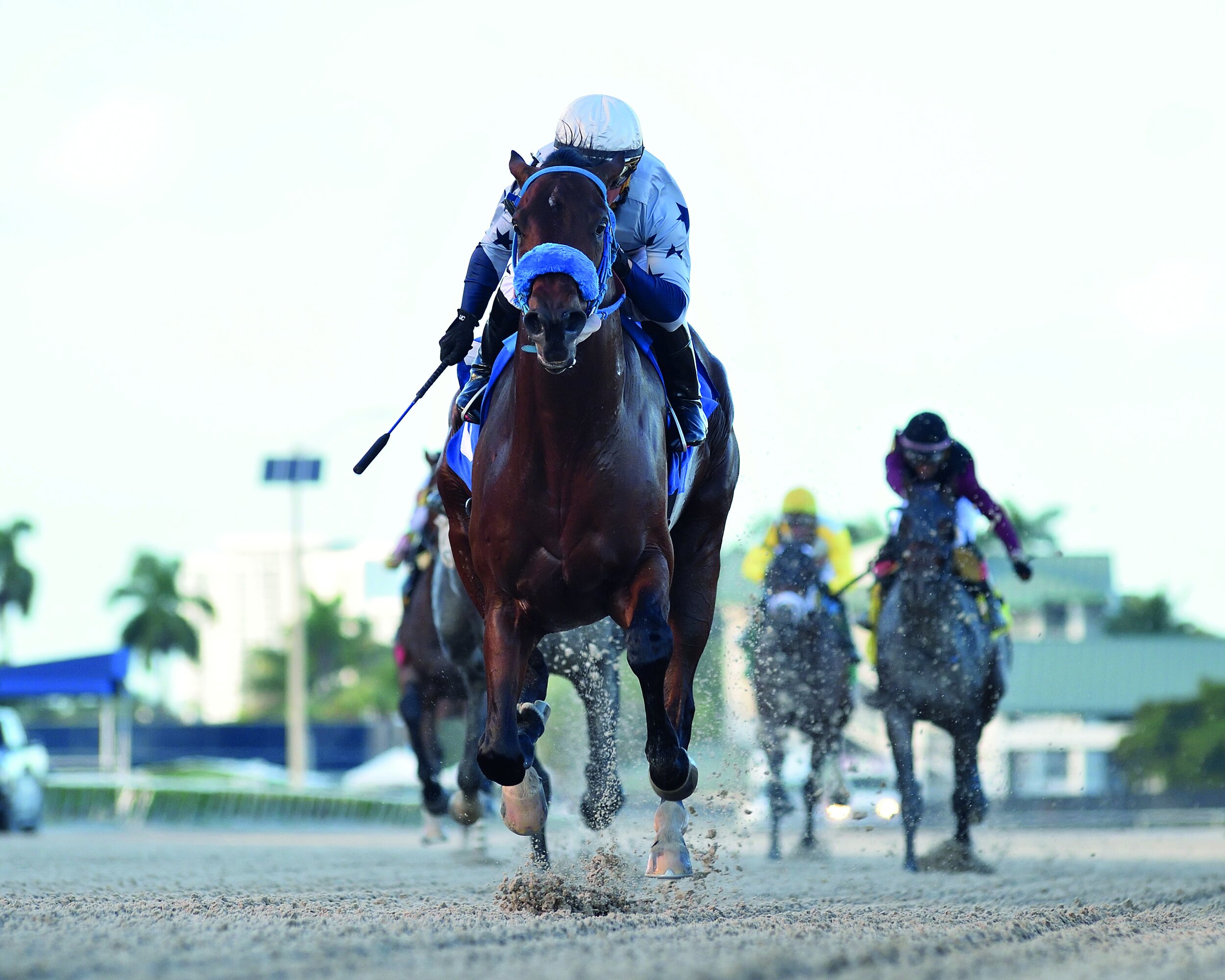Triple Crown 2025 contender owners - Jim and Claire Bryce (Jim and Claire Limited) - Heart Of Honor trained by Jamie Osborne
This time last year British based trainer, Jamie Osborne, came up with the idea of putting together a group of dirt bred horses to campaign in Dubai this past winter.
Heart of Honor, a British bred son of Honor A.P. was one that made the trip. He has now run six times and never finished out of the first two including a placed effort in the Gp.3 UAE 2000 Guineas before finishing a heart wrenching nose behind Admire Daytona in the UAE Derby (Gp.2) on the first Saturday in April - thus earning himself a guaranteed spot in the Kentucky Derby starting gate.
On his return from Dubai, Osborne indicated that Heart of Honor would more than likely bypass the first Saturday in May at Churchill Downs and instead aim his colt for the last two legs of the Triple Crown.
If he does make the trip over, Heart of Honor will be a first runner in the US for owners Jim and Claire Bryce. The Bryce’s involvement in racing has grown exponentially over the last few years, since selling their software business. In addition to the horses they have in training with Jamie Osborne, they also own the famous Rhonehurst Stables in Lambourn, from where their jumps trainer, Warren Greatrex is based.
Jamie Osborne is no stranger to running horses in major international races having trained Toast Of New York to win the UAE Derby in 2014 before finishing his 3yo season with a near miss in the Breeders’ Cup Classic (Gr.1) at Santa Anita when finishing a nose behind Bayern.
Conditioning for the Triple Crown series
Article by Bill Heller
The only constant in preparing a young horse for a shot in the Triple Crown is its difficulty. That hasn’t changed over the years.
“It’s just as difficult or more difficult now to have horses that come in healthy, and that’s your main goal: try to get them well-prepared and healthy,” trainer Todd Pletcher, a two-time Kentucky Derby winner with Super Saver (2010) and Always Dreaming (2017), said. “That’s always been a challenge, but probably more so now than ever.”
While the road to the Triple Crown was revamped with the Kentucky Derby point system beginning in 2013, the reality of the Triple Crown is the same: a horse is only going to succeed if he has a proper foundation.
“It’s like any athlete,” trainer Barclay Tagg said. “You have to get the bottom into them and bring them along slowly. It takes a while. You can’t go fast miles. They have to be slow miles. You’re building bones; you’re building tendons; you’re building ligaments all at the same time. You have to have a horse that can handle it, too. He’s got to be able to handle the effort of getting fit, just like a human athlete does. You have to have a hell of a horse to begin with. There’s a lot that goes into it.”
Tagg won the 2003 Kentucky Derby and Preakness with New York-bred Funny Cide. Seventeen years later, his New York-bred Tiz the Law won the Belmont Stakes and Travers Stakes and finished second in the Kentucky Derby. “You had to approach them differently,” Tagg said.
Both Funny Cide and Tiz the Law had three races as a two-year-old in much different company. Funny Cide won all three: a New York-bred maiden race and a pair of New York-bred stakes. Tiz the Law won a maiden race and the G. 1 Champagne before finishing third in the G. 2 Kentucky Jockey Clubs Stakes.
Tagg’s life partner/assistant trainer and exercise rider Robin Smullen, rode both horses: “Funny Cide was impossible to gallop, and by the time I started galloping him, he had holes on both sides of his mouth which bled every day, two holes from trying to run off. The ring bit put holes in the corners of his mouth.”
Tagg originally spotted Funny Cide in a yearling sale and wasn’t impressed: “I didn’t pay attention to him. I took one glance at him and didn’t like him.”
A year later, Tagg was watching Tony Everard train his young two-year-olds: “Then this horse comes barreling by me. It sounds very stupid, but it was the best thing I’d ever seen a horse do. Unbelievably fast. I just fell in love with him right away. I thought this horse ought to be a Derby horse. I know that sounds like a bunch of bull, but it’s the truth.”
It was Funny Cide. “He was so tough to ride,” Tagg said. “Robin had a division for me down at Delaware. I said, `I need you to come ride this horse.’ I got Robin to do everything for him. The rest is history.”
Tiz the Law was much easier to ride. Smullen said, “Tiz the Law was not a Funny Cide. When we were getting him ready for his maiden, we never breezed the horse fast. He had standard breezes of :48 and :49. At Saratoga one day, Mike Welsh (of the Daily Racing Form) called me and asked, `Did you really gallop this horse two miles today?’ I said, `Yeah.’ He said, `Well, there’s not too many people who work a horse two miles.’ And I said, `He likes it. He was very able to do it.’”
Smullen believes strongly in the way she and Tagg develop their young horses: “You have to warm them up well. You should never even think about galloping a horse until you’ve jogged a mile. If he can jog a mile every day, then you turn around and gallop. Even in their yearling year when you’re breaking them. You have to work them up so you don’t mess them up before you get to a race. It’s very important for bones and ligaments and tendons and the whole muscular structure.”
Once they’re fit, they begin an arduous journey. The road to the Kentucky Derby is full of potholes and detours. “The Derby is the only time when a good horse gets beat 35, 40 lengths,” trainer Bob Baffert said. “I’ve seen great horses and great trainers get beat, not win it. You have to break well, take the kickback and get into rhythm.”
You can’t win it when you’re not in it, and Baffert is returning to the Kentucky Derby after a three-year suspension at Churchill Downs following the disqualification of what would have been his historic seventh Derby winner, Medina Spirit, for a failed drug test in 2021.
Medina Spirit died in December that year when he collapsed after a workout. That didn’t make the Derby suspension any easier to deal with for Baffert: “I just blocked everything out. I figured I can’t go. I just said, `Hey, it’s not going to happen.’ It was just weird. I just focus on what’s ahead. I don’t look in the past.”
Baffert’s past in California traces back to legendary trainer Charlie Whittingham: “I watched Charlie Whittingham. He’d put a foundation into his horses before he’d run them. I put a pretty good foundation into them. It’s the way you breeze them.”
Baffert’s first Derby starter, Cavonnier, had six starts as a two-year-old and four as a three-year-old before the Derby: “I didn’t have a program then. Cavonnier took me there.”
When Cavonnier got there, he was confronted in deep stretch by D. Wayne Lukas’ colt Grindstone, beginning a rivalry still going on 30 years later between two trainers who have combined to win 10 Kentucky Derbies.
It took several agonizing minutes before Grindstone, who had drifted to the middle of the track, was declared the winner of an incredibly tight photo. “I thought he won,” Baffert said. “How do you run a mile and a quarter and lose by a nose? That was probably my worst defeat ever. I didn’t think I’d ever get back.”
Wrong. He won the next two Kentucky Derbies and Preakness Stakes with Silver Charm and Real Quiet. If Cavonnier had won that photo, Baffert would have won three straight Kentucky Derbies.
Despite Cavonnier’s narrow loss, Baffert changed his outlook on the Triple Crown: “I said that was a lot of fun. I’m going to change my program to be like Wayne Lukas. Cavonnier got me started. And people started sending me horses. Once I got a taste of it, I made my whole program like Lukas and Pletcher.”
When told of Baffert’s comment, Lukas said, “That’s an ultimate compliment from a guy that’s probably won more often than anybody.”
Baffert won two Triple Crowns with American Pharoah in 2015 and Justify, who did not race as a two-year-old, but is still the only undefeated Triple Crown winner, in 2018. “I usually put a good bottom in them before I run them,” Baffert said. “If you get a horse like Justify, he was a big, strong, heavy horse. I sort of ran him into shape. By the Derby he was at his best.”
Lukas has been at his best for decades, winning his first Triple Crown race- the 1980 Preakness Stakes, with Codex and his latest 44 years later with Seize the Gray. He’s won four Kentucky Derbies with Winning Colors (1988), Thunder Gulch (1995), Grindstone (1996) and Charismatic (1999).
There are many avenues available for trainers to prep for the Kentucky Derby: through California, Arkansas, Florida, Louisiana, Kentucky and New York. Each route offers qualifying points mandatory to get into the Kentucky Derby. “You have to get somewhere to get your points,” Tagg said. “Now, you have to be ready for the races that get you there.”
In the 1995 ‘Run for the Roses’, Lukas saddled three horses, with Timber Country and the filly Serena’s Song joining Thunder Gulch. Timber Country, who would win the Preakness Stakes, was one of the favorites and Thunder Gulch, sent off at 24-1. “I thought Timber Country was our best chance,” Lukas said. “We worked them that Monday and Donna Barton Brothers worked all three horses. She was an excellent work rider and was doing work on a lot of horses for me. Thunder Gulch was last, and when I picked her up on Thunder Gulch, I just casually said, `Well, you just had the best seat in the house. Which one’s our best chance?’ She said, `This one.’ I said, `Are you kidding?’ She said, `I like him the best.’”
When asked if he had changed anything about training horses for the Triple Crown, Lukas said, “I haven’t changed my philosophy at all on it, but I’ve noticed that some of my colleagues, the younger people, are a lot more conservative about the approach they’re taking.
“Back in the ‘50s and the ‘60s, Calumet, with all their success, always used the Derby Trial, which was one week away, as a prep. I paid attention to that a lot. Remember, the old Blue Grass was two weeks in front of the Derby, and it was one of the major preps. Now they keep moving the stakes back, like the Arkansas Derby. It had always been three weeks, now it’s five weeks. They move it back, I think, to appease the mindset of a lot of the younger trainers now. I particularly have found that most of my horses run better, horses that I have had really good success with, not necessarily winning but were competitive, ran within a month of the Derby. I used the Lexington a couple of times, and they ran well, maybe 10 days before the race.
“One of the things that I find in watching it for 50 years is, if Bob Baffert worked a horse in 1:12, the press would come over and tell everybody. A lot of these younger trainers will think, `Geez, maybe I better work my horse in 1:12.”
Lukas doesn’t: “I just think if you put good, stout gallops into them and build them up to the race, you’re better off. The reality is, if the horse is dead fit, his pedigree will either get them there or not. Strong, solid works and strong morning gallops are more instrumental. I think you put a solid bottom in them and get them into a good work pattern. Reading the horse is the hardest thing for the Derby.”
Deciding which route to get there is challenging. New York has a surprising trend. From 1930 to 2000, 11 winners of the mile-and-an-eighth Wood Memorial, now a Gr.2 stakes, won the Kentucky Derby, the last being Fusaichi Pegasus in 2000. Triple Crown winners Gallant Fox, Count Fleet, Assault, Secretariat (who finished third to his stable-mate Angle Light in 1973), all ventured to Aqueduct to compete in the Wood. From 2001 through 2024, the Wood winners haven’t added the Kentucky Derby to their resumes, though Empire Maker, Vino Rosso, Tacitus and Mo Donegal won other Gr.1 stakes.
However, another New York-bred Derby prep race, the Gr.2 Remsen Stakes for two-year-olds, annually run at Aqueduct in November after the Gr.1 Breeders’ Cup, has become an important stepping stone to future success.
Catholic Boy, the 2017 Remsen winner in a rout, returned at three to win the 2018 Travers by daylight. Mo Donegal (2021) won the 2022 Belmont Stakes. In the 2023 Remsen, Dornoch nosed Sierra Leone. Dornoch subsequently won the 2024 Belmont Stakes and the Haskell. Sierra Leone won the Blue Grass, finished second by a nose in the 2024 Kentucky Derby and won the Breeders’ Cup Classic.
Dornoch’s trainer, Danny Gargan, won the 2022 Remsen with Dubyuhnell, and chose the 2023 Remsen for Dornoch. He relished the Remsen distance of a mile-and-an-eighth: “That’s why we picked it. We always knew the further the distance the better for him. We wanted to get a two-turn race into him. You never knew going in that Sierra Leone was going to be in there. It became a key race. Both of them are multiple Grade 1 winners. One of them won the Breeders’ Cup Classic and the other won the Belmont. So it was a key race.”
Gargan appreciates the Aqueduct surface: “I’ve won the Remsen a couple of times. Aqueduct is a deep, demanding track, and it takes a fit, strong horse to be able to get that distance on that track. I think it’s beneficial if you want to get to the Derby to have a horse that can go that far. That’s the longest two-year-old race of the year. I think it helps them. There’s been some nice horses win the race the last few years. Everybody wants to say it’s not a key race, but it sure has been the last three or four years. People can say what they want, but it brings out the true distance horse. It’s all timing when you train these horses. You have to be lucky enough to have a horse that can go that far at that time.”
Though he trains in California, Eoin Harty thought the Remsen made a lot of sense for his two-year-old Poster last year. He’d won his first two starts on grass, a maiden race at Ellis Park and an allowance race at Keeneland in his first two career starts: “It was a good opportunity to see and find out whether he was capable of running on dirt. He’s a big angular horse. He’s been like that since Day One. That’s why I stretched him to a mile on the turf first time out.”
He said putting a bottom in a horse is important, but doesn’t guarantee success in longer races: “You could get an average horse, and you can put all the bottom in the world into him and he’d barely get a foot over six furlongs. It’s important, but by the time most trainers, myself included, get their hands on these horses, that baseline has been put up there. We all get these horses around the same time, usually May of the two-year-old year. And by then, it’s too late. It’s usually something I just don’t have to worry about.”
He didn’t worry about it in the 2024 Remsen. With Flavian Prat in the saddle for the first time, Poster won the Remsen by a nose. In his three-year-old debut in the mile and a sixteenth Sam F. Davis at Tampa Bay Downs, Poster got away last in the field of 10 and rallied wide to finish third by 2 ¾ lengths to John Hancock.
Harty thinks Poster will make the Derby’s mile-and-a-quarter distance if he’s given that opportunity: “I predict that he can make it, but he’s going to have to prove to me that he can make it. I mean, if, by the grace of God, I get into the starting gate on Derby Day, his ability to make a mile and a quarter won’t be a question for me. It’s up to me to have him fit to go a mile and a quarter. At some points, genetics take over. The horse will get home on his own. I think he’s the kind of horse that will go a mile and a quarter for sure.”
Antonio Sano trainer of Preakness contender - Simplification
This article was first published ahead of the 2017 Kentucky Derby - when Calder was still open for training.
We’re republishing it ahead of the 2022 Preakness Stakes - where Sano will start Simplification for owner Tami Bobo.
————————————————————————————————-
Antonio Sano is an early riser and according to his wife Maria Christina, not the greatest of sleepers in any instance. Up at 3:50 every morning come rain or shine, Sano can be found splitting time between his barns at Calder and Gulfstream Park. Between the two locations, he’s got roughly 70 horses in his care.
Assistant trainer Jesus “Chino” Prada
The two- and three-year-old are based at Calder, and the older horses are some 10 miles away at Gulfstream. “I like the track [at Calder] for the babies. It’s a good track, deep sand, and when it rains it drains, while over at the other place, it can take two days to clear.” Assistant trainer Jesus “Chino” Prada, who has been an integral member of the team since Sano started training in the U.S., chips in: “Gulfstream is great for racing, but here is the best for training.”
Sano might not yet be a household name across North America, but in his native Venezuela, the man’s a legend. He trained no less than 3,338 winners on his home soil, and it was only thanks to a kidnapping in 2009 that lasted longer than a month that he quit training in the country. The kidnapping -- his second -- resulted in the father-of-three doing what was best for his family, which was to remove them from the danger that his success was creating.
Sano is a third-generation trainer. “My father, grandfather, and uncle all worked with horses,” he recounts. “My father right now is 88 years old. He arrived from Italy when he was just 16 and was working with horses. They came from Sicily. In fact, my whole family is from there, including my wife!”
After graduating from college with a degree in engineering, the magnetic pull to the racetrack was too great, and Sano went to work as an assistant trainer Julio Ayala to enhance what knowledge and skills had been passed down to him from his father and grandfather.
Eventually (March, 1988) setting up on his own, Sano ended up training in Venezuela for 23 years, earning the trainers’ championship title 19 times and winning an average of 150 races annually, with three year-end win tallies in excess of 200. That’s no mean feat when you consider that racing only takes place twice a week in the major city of Valencia, where Sano was based.
In Venezuela, according to Sano, the pedigrees of the horses he trained were a little different than what he works with in the U.S., and so was the daily training regime. “I had 160 horses in my barn and worked the horses in four groups. Riders here take the horses to the track every 45 minutes and come back. There 4 sets of 40 horses each. Every rider work on 2 horses per set. I had the privilege to count with 20 riders at that time. We would take them all to the track at 6 A.M. At 6:45 A.M., the second set would be ready, the third by 7:30 A.M., and the last before 8:30 A.M.”
After first going from Venezuela to Italy, Sano and his family moved to the U.S. in March of 2010. They had visited the country before without spending any time at the racetrack, preferring the great vacationing opportunities that Florida offers with a young family in tow.
Well known for his training of staying types, Sano found the transition to training the speed-bred horses of the U.S. “Each horse is different, but I’ve learned more from others around me here in the U.S. than I ever learned in Venezuela,” he says -- modest words, perhaps, for a trainer who is a master of his game. “But my focus is always on the way the horses finish.”
Prada has been a friend of Sano’s for over 40 years. They attended trainer school together, along with Enrique Torres.
Their teaming up in Florida may never have happened had Sano decided to move to Italy after the kidnapping. “Italy has beautiful people and great food, but the racing wasn’t for me. So I went to Florida and met Mike Antifantis (the racing secretary at Calder at the time), who gave me a couple of stalls. I then had to go back to Venezuela and close shop, giving all my horses away.”
March 22, 2010, was an important date in Sano’s and Prada’s lives. It marked the start of a new chapter, when they claimed their first horse for their fledgling operation. The numbers quickly grew from there. “Two horses became four, and quickly we had 10,” recounts Prada.
The stable ended its first season with 37 winners, including two in stakes races. Knowing very few people or being known to few was probably a good thing for Sano as he and Prada quietly went about building their business. And where resentment for the new man in town could have quickly grown, friendships flourished with other trainers. “They treated me well and with respect,” says Sano.
With a successful formula in place, Sano’s stable was able to gradually improve the quality of stock. Still, his patronage remains primarily from Venezuelan or other Latin American ownership interests; he hasn’t really caught on with American owners.
In 2004, Sano started to shift his focus away from claiming horses to buying yearlings, while still using the claiming philosophy of trading up purchases. This time last year, Sano had high hopes for a then-unraced Broken Vow filly named Amapola, who he had bought as a yearling for $25,000. Amapola crossed the wire first by nearly 10 lengths in her May, 2016, debut in track record time for four-and-a-half furlongs at Gulfstream, only to lose the race in the stewards room for drifting in at the start. She turned a lot of heads that day, and Sano parted with her for a substantial profit. “I sold her for the money,” he says.
As with most buyers at sales, pedigree and conformation are at the top of Sano’s list when studying a catalogue page, but for him the stride of the individual and the horse’s eye are the main factors to determine if he is going to raise his hand in the ring -- should the price fall in his preferred buying range of $5,000 to $50,000.
In 2015, Sano made a number of purchases at yearling sales, and came home from the Keeneland September sale with a good-looking son of first crop sire and Florida Derby winner Dialed In.
The sale of that colt, from the consignment of Jim and Pam Robinson’s Brandywine Farm, must have been a rather bittersweet moment for breeders Brandywine and Stephen Upchurch. The chestnut’s dam Unbridled Rage had died about a week and a half after he was born, and the newly orphaned foal was bottle-fed until a foster mare could be found.
Sano with Gunnevera
That colt, for which Sano had the winning bid at $16,000, was, of course, Gunnevera. And thanks to him, if Dialed In hadn’t already been a particular favorite of Sano’s, he certainly would be now.
After the sale at Keeneland, Gunnevera, along with the other Sano purchases, was sent to Classic Mile Park in Ocala, where he was broken by Julio Rada a classmate of Sano and Prada’s at the Venezuelan training school in 1988.
Gunnevera was showing potential at Classic Mile and by the time of his arrival at Calder, his reputation was growing. However, the faith shown in him by those who knew him best wasn’t being shared by everyone: the first-time owner who Sano had bought the horse for eventually got around to paying for the colt...but the check bounced.
The name “Gunnevera” has no real meaning. It’s a combination of place names and words favored by his ownership interests -- Jamie Diaz, originally from Spain but now in Miami; and Peacock Racing, a partnership of Venezuelans Guillermo Guerra and Guerra’s father-in-law Solomon Del-Valle, who ended up with the horse just six weeks before his first run.
Del-Valle’s friendship with Sano is deeper than most normal friendships, as it was he who helped Sano’s wife arrange and finance Sano’s release from his kidnappers. “I told him that we bought horses at the yearling sale and this was the best one, that I’m going to make him a champion.” Sano’s prophecy looks like it’s showing some promise, and Gunnevera’s success has gone someway toward repaying Del-Valle’s generosity to the Sano family over the years.
————————————————————————————————-
Fast forward to 2022 and Gunnevera stands as a stallion at Pleaseant Acres Stallions in Morriston, FL. He has earned his place in the stallion barn on the back of his race record - winning the Grade 2 Saratoga Special and the Grade 3 Delta Downs Jackpot at two. At three he won the Grade 2 Fountain of Youth, finished second in both the Grade 2 Holy Bull and the Grade 1 Travers and was a game third in the Grade 1 Florida Derby.
As a four year old he finished second in a pair of Grade 1’s - The Breeders’ Cup Classic and the Woodward Stakes and ran a gallant third in the Pegasus World Cup (Gr.1). At five, his third place finish in the Dubai World Cup (Gr.1) meant that he retired with earnings of over $5.5m and as such has become the highest ever earner to stand at stud in Florida.
Gunnevera was not his trainer’s first graded stakes winner; although none received anywhere near the level of acclaim as the son of Dialed In. Sano previously handled Devilish Lady, City of Weston, and Grand Tito to graded stakes wins.
Sano is the first to admit that nothing has compared to the Gunnevera success story and the national exposure he received. But how well does he react to the inevitable pressure? “I’ve never been in a situation like this before, but it’s a blessing,” he calmly says. For Maria Christina, it’s as if her husband’s life is going on just the same. “He never sleeps before any race, he’s always thinking about something.”
Come to think of it, Sano’s whole day and night seems to be taken up with work or thinking about horses. The work day often ends 16 hours after it began, giving Sano a little much-needed family time with his three children. His eldest son Alessandro is already following in the family business and now works as one of his father’s assistant trainers.
But what about time away from horses, does Sano take a vacation? “One week -- and I don’t relax,” he says. “He’s always on the phone to Chino and I say, ‘No phone, Tony, the horses won’t run faster with you not there,’” interjects Maria Christina.
“Twenty (five) years ago when Alessandro was born, I would never have thought that I would be where I am now,” says Sano.
“But Tony, you were scared to come here 20 years ago. There wasn't the opportunity we have here in Venezuela,” retorts Maria Christina.
So Venezuela’s loss is America’s gain, and this is one family truly living the American dream.
First published in North American Trainer issue 44 - May - July 2017
Buy this back issue here!
Preakness Stakes - Owner Profile - Tami Bobo - Simplification
By Bill Heller
Having loved, ridden and worked with horses for 46 of her 48 years, and having dealt with Arabians, Quarter Horses and Thoroughbreds, you’d think Tami Bobo would have picked up all the equine knowledge she’ll ever need. Wrong.
Asked if she is still learning, Tami said, “One hundred percent, if you just watch them. I learn every day from horses. I love to learn, so I enjoy it. Most recently, I’ve been learning about this industry. It’s fascinating. Not being born into it, I wasn’t exposed to people approaching you wanting to buy your horses.”
The most inquiries have been about one horse, Simplification, who will take Tami and Simplification’s trainer, Antonio Sano, to the Preakness Stakes off a solid dirt record of three victories, one second, two thirds and a fourth placed finish last time out in the Kentucky Derby. “My hat’s off to Antonio, managing a staff, trying to execute a plan,” Tami said. “Most recently, my learning is how to manage a Kentucky Derby contender.”
Now the learning journey moves on to Baltimore where Simplification will break from the #1 hole in the 2022 Preakness Stakes.
She may not have been born into horse racing, but she didn’t miss by much. “I have pictures of me on a horse when I was less than two-years-old,” she said. “My family moved to Ocala when I was eight years old. I showed horses all over the country.”
Working at one point as a single mother, she had to hustle to make a living with horses. “Quarter Horses were keeping me whole,” she said. “I was teaching riding lessons and pinhooking Quarter Horses. I did very well pinhooking, but the profit with Quarter Horses is small. It kept food on the table.”
Asked how she has dealt with different breeds, she said, “I think at the end of the day, it’s horsemanship. You are either a horseman or you’re not. If you know horses and pay attention, they will tell you what they need. Then you address any issues. There’s an idea that horses aren’t intelligent. It’s a misconception. Horses are extremely intelligent. They have to have intelligence and the mindset to race.”
Simplification, jockey Javier Castellano, and Tami Bobo celebrate after winning the Mucho Macho Man Stakes at Gulfstream Park, 2022
In 2010, Bobo switched from Quarter Horses to Thoroughbreds and is still enjoying the wisdom of that decision. And the first Thoroughbred she bought was Take Charge Indy, a phenomenally bred colt by A.P. Indy out of multiple graded-stakes winner Take Charge Lady, whose victories included the Gr. 1 Ashland and Spinster Stakes.
Take Charge Indy was entered in the 2010 Keeneland September Yearling Sale, but failed to reach the $80,000 reserve price because of a conformation issue and a short stride. Bobo saw a great opportunity and took it, believing the colt could overcome his deficiencies over time.
And that’s exactly what he did under the astute handling of trainer Patrick Byrne. Take Charge Indy won the Gr. 1 Florida Derby by a length under Calvin Borel. That earned a spot in the starting gate for the Kentucky Derby, but Take Charge Indy couldn’t keep up, finishing 19th of 20 by 50 lengths.
Borel originally believed the horse had bled, but veterinarians discovered he had chipped a bone in his left front ankle. He underwent surgery and during his recovery was sold to WinStar Farm and Chuck and Maribeth Sandford.
He then finished third in the Gr. 2 Fayette, second by a length in the Gr. 1 Clark Handicap, third in the Gr. 1 Donn Handicap, and second in the Gr. 3 Skip Away Stakes before winning the Gr. 2 Alysheba Stakes by six lengths under Rosie Napravnik.
Simplification will take Tami Bobo and trainer Antonio Sano to the Kentucky Derby off a solid dirt record of 3 victories, 1 second and 2 thirds in 6 starts
For his career, he had three wins, four seconds and two thirds from 14 starts with earnings topping $1.1 million. He has also proven to be a good stallion, standing for $12,5000 at WinStar Farm in 2022 after having sired 586 winners with earnings of just under $19 million. Not a bad racing/stud career for a yearling that nobody but Tami wanted.
Six years ago, Tami and her husband Fernando De Jesus purchased Plumley Farm in Ocala and renamed it First Finds. “We have a weanling, yearlings and pinhooking operation,” Tami said. “We do an average of about 20 pinhooks every year. We do small numbers, so we’re hands-on every day.”
Of course they are. They’re still learning.
The ultimate challenge - Entering the winner’s circle in a Triple Crown race
CLICK ON IMAGE ABOVE TO READ THE ARTICLE
This article appeared in North American Trainer - issue 40 (May to July 2016)











